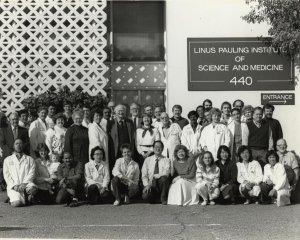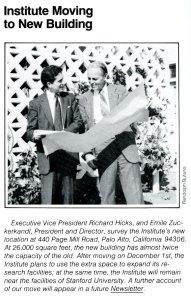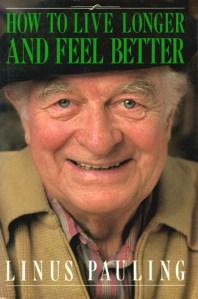
Linus Pauling Institute of Science and Medicine staff portrait, 1989.
[A history of the Linus Pauling Institute of Science and Medicine, Part 4 of 8]
In the spring of 1980, amidst a swirl of funding difficulties and legal actions, Emile Zuckerkandl was named President and Director of the Linus Pauling Institute of Science and Medicine. He quickly began working to expand LPISM into a more wide-ranging organization with a particular focus on cellular research. His leadership style was very different from the Institute’s previous presidents, but the staff liked him and generally supported his initiatives.
By this point, born of need, Linus Pauling’s relationship with the Institute began to assume a somewhat Faustian character. Pauling was contacted by, and began regularly meeting with, a man named Ryoichi Sasakawa to discuss future collaboration plans and possible donations. Sasakawa was a world-renowned philanthropist and famous businessman who had single handedly introduced and popularized motorboat racing in Japan. Sasakawa was also very controversial. An avowed fascist, he was an admirer of Benito Mussolini and a political strongman who had been charged with war crimes for his activities in support of the Japanese government during World War II. He was also very wealthy and Pauling’s connection to Sasakawa would grow over time.
The summer and early fall of 1980 were largely preoccupied with the Art Robinson suits and fundraising. In August LPISM finally received some good news: the National Science Foundation had awarded the Institute a grant of $40,000 a year for two years to support research on the structure of molecules and complex ions containing transition metals. This provided a much needed financial boost, as finances were suffering greatly from the Mayo trials and the ongoing legal wrangling with Robinson.
The year ended somewhat stressfully when, in December, LPISM was forced to move from Menlo Park to 440 Page Mill Rd. in Palo Alto. The landlord of their building in Menlo Park had evicted all of his tenants while he was making structural repairs to the facility. Once completed, he decided not to welcome LPISM back, instead inviting more profitable companies to take their spot. The new building in Palo Alto was dramatically bigger and less expensive; it was also quite a bit shabbier, in part because it was made out of cinderblocks. Employee Alan Sheets was able to help save the Institute a lot of money during the transition, as his father was a professional mover. As such, the Sheets family helped LPISM move itself instead of hiring the process out to a company.

Extracted from the LPISM Newsletter, Winter 1980.
The dawn of 1981 brought with it major financial relief for LPISM. After eight failed tries over eight long years, the National Cancer Institute finally agreed to fund a component of LPISM’s program – a two-year grant for $204,000 to research the effects of vitamin C on breast cancer in mice. At about the same time, Sasakawa’s company, the Japanese Shipbuilding Foundation, pledged $5 million to the Institute over the following ten years. As part of the deal, LPISM began working with Sasakawa to create the Sasakawa Aging Research Center, which was set up as a satellite facility on Porter Drive. Later in the 1980s, the building at Porter Drive suffered a major roof leak which destroyed thousands of pages of research and documentation. Thomas Hager, one of Pauling’s biographers, notes that LPISM successfully sued the landlord for neglecting to maintain the building.
Despite this influx of new cash, the close of 1981 proved to be an awful time for Linus Pauling and LPISM. In August, Ava Helen Pauling’s recurrent stomach cancer was declared inoperable and on December 7, after struggling with cancer for five years and three months, Ava Helen died. Linus Pauling was absolutely devastated, and the LPISM staff was greatly saddened by the loss as well. Pauling understandably did not cope well with the passing of the woman who was his wife for nearly 60 years, and he effectively ceased to be involved in LPISM except in the most cursory of ways, choosing instead to spend much of his time alone at his ranch in Big Sur, California.
The year that followed was, unsurprisingly, a tough one. Pauling remained in mourning and didn’t really contribute to LPISM, the Robinson suits dragged on, and the Institute’s fundraisers still struggled to cope with the fallout from the Mayo Trials. The NCI and Sasakawa donations helped to keep operations running, as did some of the revenue from Pauling and Cameron’s book, Cancer and Vitamin C. In the summer of 1982, Pauling took a trip throughout the Pacific Northwest where he visited many of his and Ava Helen’s favorite spots, as well as the cemetery where his maternal grandfather Linus Wilson Darling rested. The trip brought him closure and by the fall he became active at the Institute again.
In February 1983, the lawsuits with Arthur Robinson finally ended, with LPISM paying an out of court settlement of $575,000. The Institute adamantly maintained no wrong doing, instead acknowledging the fiscal prudence of settling as opposed to prolonging the court battle, which was nearly five years old by that point.
Their legal problems resolved, LPISM fundraisers redoubled their efforts to regain their financial momentum, as the lawsuits had drained them of resources. Past fundraising techniques were unable to generate much steam, so Rick Hicks began cultivating relationships with individual, extremely wealthy donors, notably Armand Hammer, Ryoichi Sasakawa and Danny Kaye. As a part of this strategy, LPISM began annually awarding individuals – typically major donors – the Linus Pauling Medal for Humanitarianism. Sasakawa was its first recipient.
In November 1983, LPISM researchers announced that they had discovered a new type of chemical bond that mimicked the bond believed to exist between bulk metals. This was a fairly important discovery, and also helped restore some measure of favorable public opinion as people saw the good work that LPISM was doing. The announcement also reminded folks that LPISM wasn’t just about vitamin C research. The next year, in 1984, Pauling received the extremely prestigious Joseph Priestley Medal from the American Chemical Society for his lifetime of work and dedication in the field of chemistry.
However, the controversy over vitamin C was never far from the Institute and more arrived in a hurry when, on January 2, 1985, the Mayo Clinic released the results of its second set of trials. The Institute was given no warning of the release or chance to read the results in advance. This infuriated Pauling who saw it as an obvious insult levied by the study’s principal investigator, Charles Moertel.

Pauling Note to Self, January 14, 1985.
Perhaps unsurprisingly, Moertel announced that the study had reaffirmed his earlier assertion that vitamin C was useless in cancer treatment. Upon reading the report though, Pauling deduced that Moertel hadn’t actually examined Ewan Cameron’s papers, the very studies he was supposed to be replicating. Among other deviations, the amount of vitamin C used in the Mayo trials was lower than in Cameron’s studies, the amount of time that patients had been given vitamin C was shorter and patients were given vitamin C orally instead of intravenously. Both Pauling and Cameron publicly branded the Mayo report as “fraudulent” and angrily decried the false assertion that Moertel had closely replicated their work.
Many journals and newspapers refused to publish Pauling and Cameron’s rebuttals, or published them months after they were submitted such that the responses were no longer relevant. As a result, LPISM suffered still more financial hardships as public opinion once again swung away from the Institute and many people stopped donating. The direct-mail appeals that had been so successful in years past were only bringing in 25% of what they had a few months previously.
By 1986 LPISM was struggling with funding and also public awareness – the second Mayo Clinic trial seemed to have largely sealed public opinion on vitamin C research. But Pauling was still convinced that vitamin C had more merit than was being considered, and in support of this cause he published How to Live Longer and Feel Better. The book was well-received by critics and sold well.
For the Institute, its successes were manifold, as it provided a morale boost to LPISM staff, brought in sorely needed funds and dramatically raised awareness of the organization and its activities. Shortly afterward, Cameron and fellow LPISM employee Fred Stitt found themselves swamped with phone calls and letters to the Institute about health questions and recommendations. They quickly developed a standardized health information packet which they would mail out to people making more generic inquiries.

Nonetheless, as always, controversy was hovering over the Institute like a thunderhead. In 1987 Institute staffer Raxit Jariwalla began to research the effect of vitamin C on HIV/AIDS treatment. After a short period of time, Pauling became interested in the research and eventually Cameron did as well. Pauling began advocating increased usage of vitamin C in treating what seemed to be an incurable disease; the response was immediate and dramatic. Local donations increased, as the Bay Area was particularly sensitive to the hazards posed by HIV/AIDS. However, at the very same time, other sources of funding dropped as numerous groups and individuals pulled their support, stating that HIV/AIDS was a “moral disease.”
Through it all, the Institute continued to follow Zuckerkandl’s lead in expanding its research into areas outside the realm of orthomolecular medicine. In 1987 researchers began extensive work on protein profiling and the effect of phytic acid in cancer prevention, a program that was more or less entirely supported by a philanthropist based in New York.
The Institute also began working on superconductivity in 1988. In particular, Pauling hoped to develop a room-temperature superconductor which he could then market as a stable revenue source for the Institute. Zuckerkandl, Steve Lawson, Pauling and even Cameron began working on this project, which utilized a material made out of borosilicate glass and tin. The process involved using a blowtorch and an inverted bicycle with its tires taken off the wheels. Pauling would often come down to the labs and help with the physical research and experimentation – it was the last research project he actively participated in. The process worked and the material was developed according to Pauling’s specifications. He received a patent for it early in 1989, and immediately began trying to market it, though ultimately without success.
The decade of the 1980s drew to a close on a mixed note for LPISM. The organization was, as always, struggling with controversy and financial problems. However, research was progressing well, popular support was increasing, and Pauling had come to terms with the death of his wife. The decade had seen its ups and downs, and what lay ahead would be no different.
